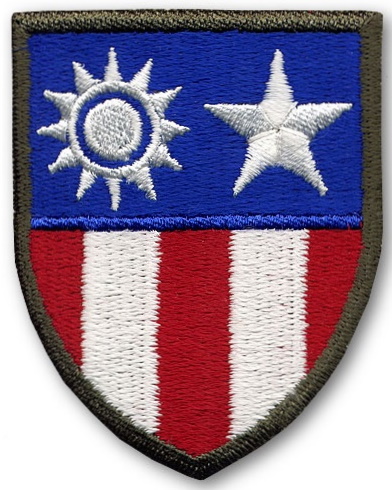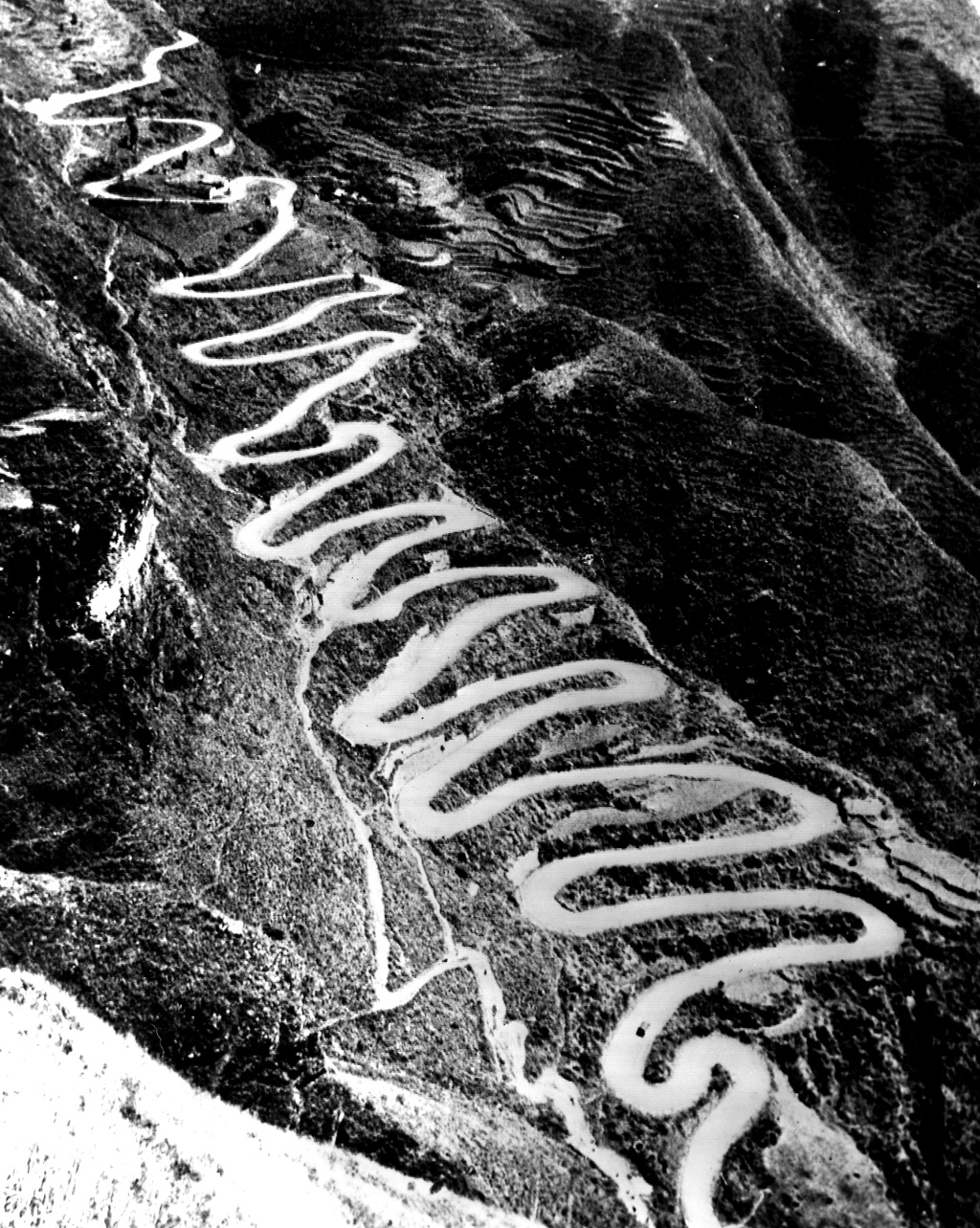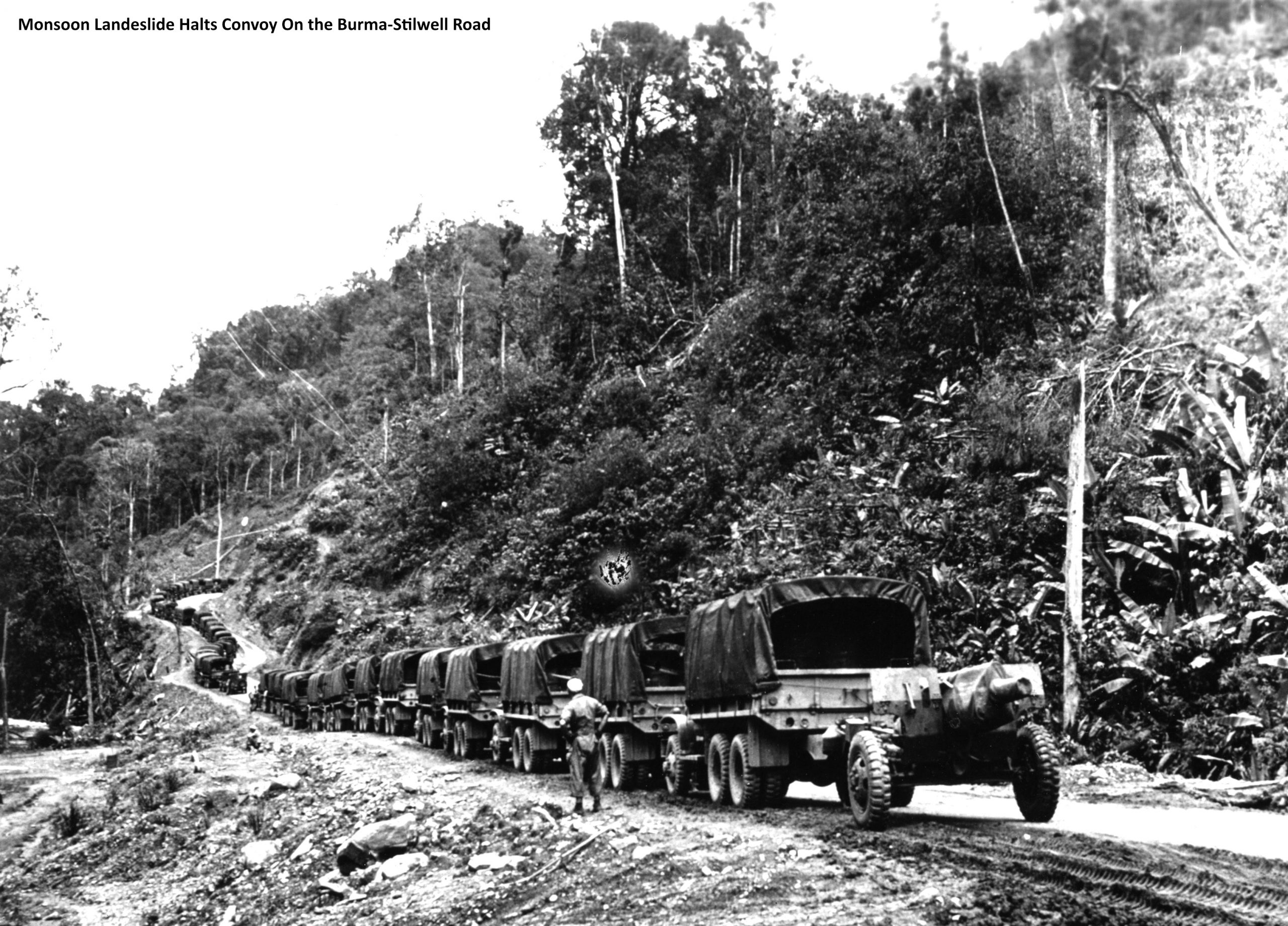Document Source, US Army Center of Military History, EUCMH research online (Photo NARA, EUCMH Collection) (Definitive Version, Doc Snafu, October 26, 2022)
 On December 1, 1942, Gen Sir Archibald Wavell (UK), the supreme commander of the Far Eastern Theater, agreed with Gen Joseph Stilwell (US) to make the Ledo Road an
On December 1, 1942, Gen Sir Archibald Wavell (UK), the supreme commander of the Far Eastern Theater, agreed with Gen Joseph Stilwell (US) to make the Ledo Road an
Stilwell’s staff estimated that the Ledo Road route would supply 65.000 tons of supplies per month, greatly surpassing the tonnage then being airlifted over the Hump (Air Route over the Himalayas) to China.
 Gen Claire Lee Chennault, CG of the US Fourteenth Army Air Force, thought the projected tonnage levels were overly optimistic and doubted that such an extended network of trails through the difficult jungle could ever match the number of supplies that could be delivered with modern cargo transport aircraft, approving that aid to China was one thing, but getting it there was another one. Japan had already seized China’s coastal provinces and the Japanese move into Northern Indochina in September 1941 had cut the railroad from there to the Yunnan Province. That left the route from Rangoon in Burma to Yunnan as the only land supply line available to the Americans. When the Japanese threatened that route, Gen John Magruder, the US lend-lease administrator in China, sent engineer Maj John E. Ausland to look for an alternate route to China from India through northern Burma. Ausland reported that the terrain there was very difficult, especially in the Patkai Mountains along the Burma-India Border. When America’s entry into the war brought a request from Gen Chiang Kai-shek for an American general officer to be his chief of staff, the US sent Gen Joseph W. Stilwell. He was also named CG of the US Army Forces in the China Burma India theater of operations (CBI).
Gen Claire Lee Chennault, CG of the US Fourteenth Army Air Force, thought the projected tonnage levels were overly optimistic and doubted that such an extended network of trails through the difficult jungle could ever match the number of supplies that could be delivered with modern cargo transport aircraft, approving that aid to China was one thing, but getting it there was another one. Japan had already seized China’s coastal provinces and the Japanese move into Northern Indochina in September 1941 had cut the railroad from there to the Yunnan Province. That left the route from Rangoon in Burma to Yunnan as the only land supply line available to the Americans. When the Japanese threatened that route, Gen John Magruder, the US lend-lease administrator in China, sent engineer Maj John E. Ausland to look for an alternate route to China from India through northern Burma. Ausland reported that the terrain there was very difficult, especially in the Patkai Mountains along the Burma-India Border. When America’s entry into the war brought a request from Gen Chiang Kai-shek for an American general officer to be his chief of staff, the US sent Gen Joseph W. Stilwell. He was also named CG of the US Army Forces in the China Burma India theater of operations (CBI).
At the start of the war, the British had two commands with responsibilities for possessions in the theater. India Command under Gen Sir Archibald Wavell the Commander-in-Chief (CiC) of the Army of India and the Far East Command, first under Air Chief Marshal Robert Brooke-Popham and then from December 23, 1941, commanded by Gen Sir Henry Royds Pownall. The India Command was responsible for British India, British Ceylon, and for some time Burma. The Far East Command based in Singapore was responsible for Hong Kong, Malaya, Singapore, and other British Far East possessions including, for some of the time, Burma. A month after the outbreak of war with Japan on December 7, 1941, the Allied governments jointly appointed the British Commander-in-Chief (CIC) of the Army of India, Gen Archibald Wavell, as Supreme Allied Commander of all ‘American British Dutch Australian’ (ABDA) forces in Southeast Asia and the Pacific, from Burma to the Dutch East Indies. Later, advances made by the Japanese over the next month split the ABDA forces in two. So, after transferring the forces in Burma to the India Command, on February 25, 1942, Wavell resigned as commander of the ABDA and resumed his position of CiC of the Army of India. Responsibility for the Southwest Pacific Area passed to US Gen Douglas MacArthur as Supreme Allied Commander Southwest Pacific.
 From February 1942, until November 1943, the India Command was responsible for the Southeast Asian Theater. Gen Wavell was made Viceroy of India and Gen Claude Auchinleck became CiC of the India Command on June 20, 1943. In August 1943, the Allies formed a new Southeast Asian Command to take over strategic responsibilities for the theater. The reorganization of the theater command took about two months. On October 4, Sir Winston Churchill appointed Adm Louis Mountbatten Supreme Allied Commander of the Southeast Asia Command (SEAC) while Gen Joseph Stilwell became the first deputy supreme Allied commander. On November 15, Auchinleck handed over responsibility for the conduct of operations against the Japanese in the theater to Mountbatten.
From February 1942, until November 1943, the India Command was responsible for the Southeast Asian Theater. Gen Wavell was made Viceroy of India and Gen Claude Auchinleck became CiC of the India Command on June 20, 1943. In August 1943, the Allies formed a new Southeast Asian Command to take over strategic responsibilities for the theater. The reorganization of the theater command took about two months. On October 4, Sir Winston Churchill appointed Adm Louis Mountbatten Supreme Allied Commander of the Southeast Asia Command (SEAC) while Gen Joseph Stilwell became the first deputy supreme Allied commander. On November 15, Auchinleck handed over responsibility for the conduct of operations against the Japanese in the theater to Mountbatten.
The initial land forces operational area for SEAC included India, Burma, British Ceylon, and Malaya. Operations were also mounted in Japanese-occupied Sumatra, Thailand, and French Indochina (Vietnam, Cambodia, and Laos). Initially, SEAC commanded: the British Eastern Fleet (based in Ceylon); the British 11th Army Group (Commonwealth land forces – Hq in New Delhi); the Air Force Hq India (New Delhi), and the China Burma India Theater (CBI), (all the US forces in theater, Hq in New Delhi). In October 1944, the CBI has split into the US Forces China Theater (USFCT) and the India Burma Theater (USFIBT). On November 12, 1944, the Eleventh Army Group was re-designated by Allied Land Forces South East Asia (ALFSEA) combining Commonwealth and US forces with a Hq at Kandy. On December 1, ALFSEA Hq moved to Barrackpore, India. On August 15, 1945, responsibility for the rest of the Dutch East Indies was transferred from the Southwest Pacific Area to SEAC which SEAC was disbanded on November 30, 1946.
 It was as Chief of Staff that Stilwell got first involved in theater operations. The Japanese seized Rangoon in March 1942, shortly after he arrived, and Chiang sent Chinese troops into Burma. He asked Stilwell to coordinate their use with the British who were responsible for the defense of the area. This first Burma Campaign was a losing effort. Stilwell walked out of Burma in May 1942 bringing with him to India the remnants of two Chinese divisions. He still had the mission of supporting China, but he no longer had a land supply line; the Japanese offensive had cut the Burma Road.
It was as Chief of Staff that Stilwell got first involved in theater operations. The Japanese seized Rangoon in March 1942, shortly after he arrived, and Chiang sent Chinese troops into Burma. He asked Stilwell to coordinate their use with the British who were responsible for the defense of the area. This first Burma Campaign was a losing effort. Stilwell walked out of Burma in May 1942 bringing with him to India the remnants of two Chinese divisions. He still had the mission of supporting China, but he no longer had a land supply line; the Japanese offensive had cut the Burma Road.
 Stilwell would have to clear a path for a new road right through the terrain Maj Ausland had found so difficult. Only now there was an additional challenge; the Japanese occupied most of the terrain. By the fall of 1942, Stilwell had a plan. The British agreed to a North Burma Campaign to clear the road and assigned the area to Stilwell. In November Chiang Kai-shek approved the use of the Chinese forces and named Stilwell their commander. Gen George C. Marshall, Chief of Staff (CoS) US Army, promised Stilwell absolute priority for troops and equipment second only to the North African Campaign, but soon found he could not keep that promise. Stilwell’s operations officer, Col Frank D. Merrill, recommended building a road from Ledo in the Assam Province, India, South, and East across Northern Burma to a junction with the old Burma Road. The new road would support a North Burma Campaign and, when linked with the old, provide a land supply line to China. Merrill chose Ledo because it was near the terminus of the rail line from Calcutta and was at the northern end of a caravan route out of Burma. The concept was for US Army Engineers to build a road generally following the caravan route from Ledo south through the Patkai Mountains and the Hukawng and Mogaung valleys, to connect with the old Burma Road east of Bhamo.
Stilwell would have to clear a path for a new road right through the terrain Maj Ausland had found so difficult. Only now there was an additional challenge; the Japanese occupied most of the terrain. By the fall of 1942, Stilwell had a plan. The British agreed to a North Burma Campaign to clear the road and assigned the area to Stilwell. In November Chiang Kai-shek approved the use of the Chinese forces and named Stilwell their commander. Gen George C. Marshall, Chief of Staff (CoS) US Army, promised Stilwell absolute priority for troops and equipment second only to the North African Campaign, but soon found he could not keep that promise. Stilwell’s operations officer, Col Frank D. Merrill, recommended building a road from Ledo in the Assam Province, India, South, and East across Northern Burma to a junction with the old Burma Road. The new road would support a North Burma Campaign and, when linked with the old, provide a land supply line to China. Merrill chose Ledo because it was near the terminus of the rail line from Calcutta and was at the northern end of a caravan route out of Burma. The concept was for US Army Engineers to build a road generally following the caravan route from Ledo south through the Patkai Mountains and the Hukawng and Mogaung valleys, to connect with the old Burma Road east of Bhamo.
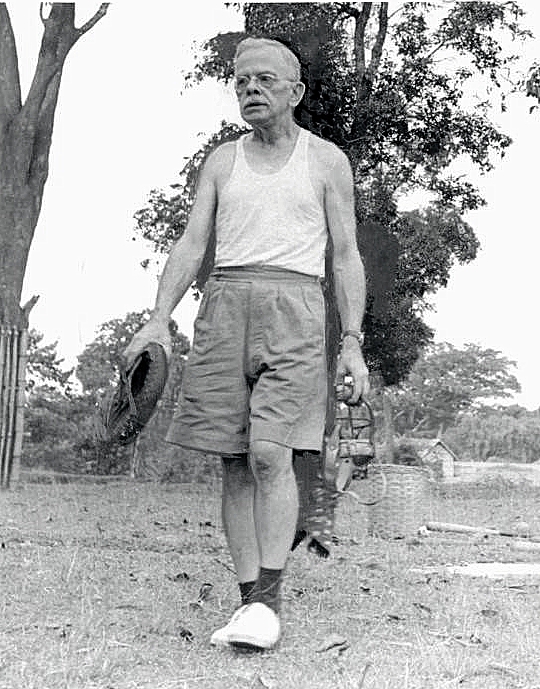 The proposed route for the road went through some of the most difficult terrains in the world. The triangular-shaped territory of Northern Burma included jungle-covered mountains and swampy valleys. It was virtually uninhabited with the major towns being nothing more than frontier posts. The mountains, offshoots of the Himalayas, were formidable land barriers that rose to heights of 8000 to 10000 feet. The Hukawng and Mogaung valleys were tropical rain forests, dark and silent, with matted undergrowth where the clearings were really swamps covered with elephant grass 8 to 10 feet tall. According to Dr. Gordon Seagrave, the famed ‘Burma Surgeon’, this unattractive area was the ancestral home of the leech. He found three major types: (1) big brown ones on the ground; (2) red ones in the elephant grass and (3) green on the tree branches. While the leeches wore pests, malaria-bearing mosquitoes and typhus-carrying mites could be deadly in the absence of strict preventive medicine measures. There are two seasons in Northern Burma, wet and dry. The wet monsoon season lasts from May to October when the rainfall is heavy, averaging 140 inches in the mountains and 120 inches annually in the valleys. By comparison, the east coast of the US gets about 45 inches in a year. Although the monsoon season produces hot, humid weather, the dry season is a very comfortable period of California-type weather.
The proposed route for the road went through some of the most difficult terrains in the world. The triangular-shaped territory of Northern Burma included jungle-covered mountains and swampy valleys. It was virtually uninhabited with the major towns being nothing more than frontier posts. The mountains, offshoots of the Himalayas, were formidable land barriers that rose to heights of 8000 to 10000 feet. The Hukawng and Mogaung valleys were tropical rain forests, dark and silent, with matted undergrowth where the clearings were really swamps covered with elephant grass 8 to 10 feet tall. According to Dr. Gordon Seagrave, the famed ‘Burma Surgeon’, this unattractive area was the ancestral home of the leech. He found three major types: (1) big brown ones on the ground; (2) red ones in the elephant grass and (3) green on the tree branches. While the leeches wore pests, malaria-bearing mosquitoes and typhus-carrying mites could be deadly in the absence of strict preventive medicine measures. There are two seasons in Northern Burma, wet and dry. The wet monsoon season lasts from May to October when the rainfall is heavy, averaging 140 inches in the mountains and 120 inches annually in the valleys. By comparison, the east coast of the US gets about 45 inches in a year. Although the monsoon season produces hot, humid weather, the dry season is a very comfortable period of California-type weather.
 While the terrain and weather were formidable barriers for the engineers to overcome, the enemy initially posed less of a problem. After the Japanese conquered central Burma, 330 Builders, and Fighters in early 1942, they consolidated their position during the monsoon season and did not move forces north of Myitkyina. Gen Renya Mutaguchi’s veteran 18th Japanese Division, conquerors of Singapore, out posted the area but made no movement north in the Mogaung Valley.
While the terrain and weather were formidable barriers for the engineers to overcome, the enemy initially posed less of a problem. After the Japanese conquered central Burma, 330 Builders, and Fighters in early 1942, they consolidated their position during the monsoon season and did not move forces north of Myitkyina. Gen Renya Mutaguchi’s veteran 18th Japanese Division, conquerors of Singapore, out posted the area but made no movement north in the Mogaung Valley.

 The Chinese troops, who would face this Japanese force in the North Burma Campaign, began training in India in the summer of 1942. To support them, Gen Stilwell organized a Service of Supply (SOS) under the command of Gen Raymond A. Wheeler. Stilwell had known Wheeler as one of his language students at West Point and had developed a high opinion of his engineering abilities. A career Army engineer, Wheeler had won recognition as a road builder while commanding the 4th Division’s engineers in the Argonne Forest Campaign in World War One. Stilwell made SOS responsible for construction in India and Burma.
The Chinese troops, who would face this Japanese force in the North Burma Campaign, began training in India in the summer of 1942. To support them, Gen Stilwell organized a Service of Supply (SOS) under the command of Gen Raymond A. Wheeler. Stilwell had known Wheeler as one of his language students at West Point and had developed a high opinion of his engineering abilities. A career Army engineer, Wheeler had won recognition as a road builder while commanding the 4th Division’s engineers in the Argonne Forest Campaign in World War One. Stilwell made SOS responsible for construction in India and Burma.
In response to Wheeler’s request, the War Department sent him the 45th Engineer General Service Regiment and the 823d Engineer Aviation Battalion. The two units arrived in Karachi, India, in July.
They did not have any of their equipment and had to use lend-lease stock earmarked for China, but they were on the ground, in the theater.
ENGINEER IN BURMA
 45th Engineer General Service Regt
45th Engineer General Service Regt
71st Engineer Light Pontoon Co
75th Engineer Light Pontoon Co
77th Engineer Light Pontoon Co
93rd Engineer General Service Regt
195th Engineer Dump Truck Co
209th Engineer Combat Bn
236th Engineer Combat Bn
330th Engineer General Service Regt
352nd Engineer General Service Regt
479th Engineer Maintenance Co
497th Engineer Heavy Shop Co
797th Engineer Forestry Co
823rd Engineer Aviation Engineer Bn
848th Engineer Aviation Engineer Bn
849th Engineer Aviation Engineer Bn
858th Engineer Aviation Engineer Bn
1327th Engineer General Service Regt
1359th Engineer Dump Truck Co
1388th Engineer Forestry Co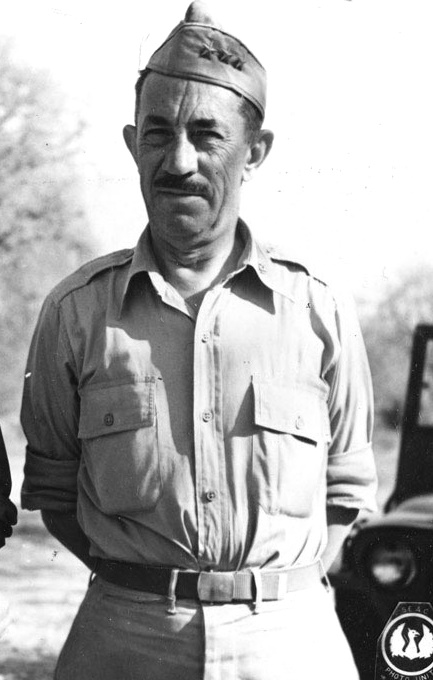
1575th Engineer Heavy Shop Co
1875th Engineer Aviation Bn
1883rd Engineer Aviation Bn
1905th Engineer Aviation Bn
4023rd Quartermaster Dump Truck Co
4024th Quartermaster Dump Truck Co
Note: From the middle of April until the middle of May 1944, Able Co, 879th Airborne Engineer Battalion worked 24 hours a day on the Ledo Road, construction of their base camp and the Shingbwiyang Airfield, before deploying to the area of Myitkyina to improve the facilities of the old British Airfield which had been recently captured by the Japanese.
Zones Repartition
District One (D1)
352-EGSR; 93-EGSR; 849-EAB
District Two (D2)
45-EGSR; 75-ELPC; 1327-EGSR
District Three (D3)
10-Chinese ER; 77-ELPC; 330-EGSR; 823-EAB; 1359-EDTC; 1883-EABn; 1875-EAB; 4023-QMDTC
District Four (D4)
12-Chinese ER; 71-ELPC; 195-EDTC; 209-ECB; 236-ECB; 1905-EAB; 4024-QMDTC
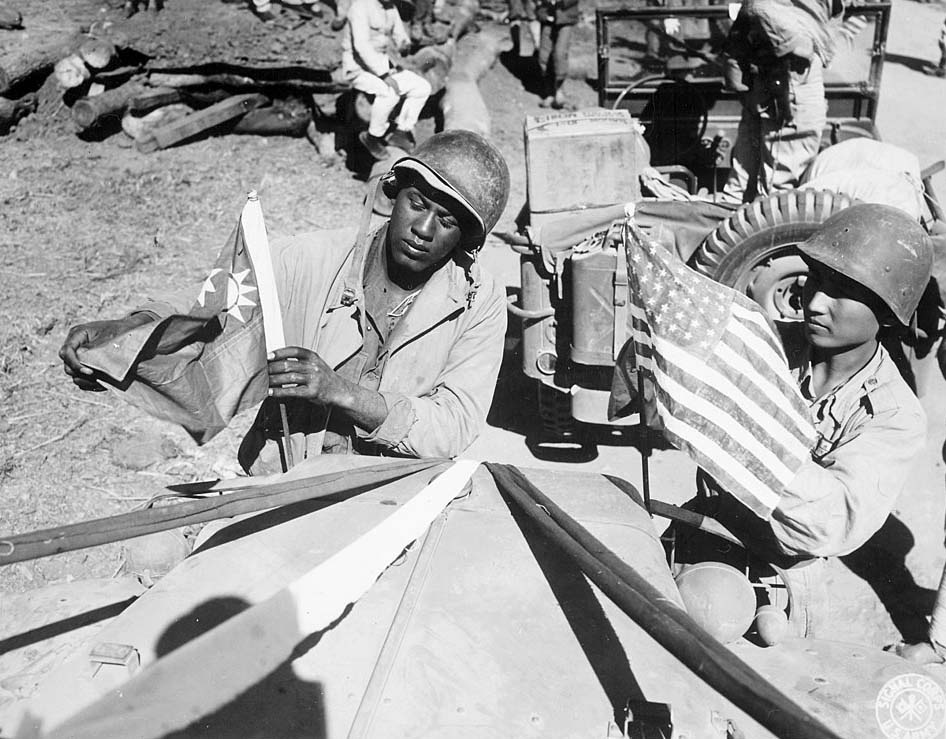 Road Headquarters
Road Headquarters
479-EMC; 497-EHSC; 797-EFC; 1388-EFC; 1575-EHSC; Sawmill Crew 45-EB at Shingbwiyang.
Wheeler established Base Section 3 at Ledo, made it responsible for building the road, and named the 45th Regiment’s commander, Col John C. Arrowsmith, as base commander. Arrowsmith had his own 45th Regiment and the 823d Engineer Aviation Battalion began the road project, putting them to work first building warehouses, hospitals, barracks, and base roads at Ledo. Work started on the first 103 miles (166 KM) section of the road in December 1942, followed a steep, narrow trail through the territory from Ledo, across the Patkai Range through the Pangsau Pass, nicknamed ‘Hell Pass‘ for its difficulty, and down to Shingbwiyang in Burma. Sometimes rising as high as 4500 feet (1400 M), the road required the removal of the earth at the rate of 100.000 cubic feet per mile (1800 M³/Km). Steep gradients, hairpin curves, and sheer drops of 200 feet (60 M), all surrounded by a thick rainforest were the norm for this first section.
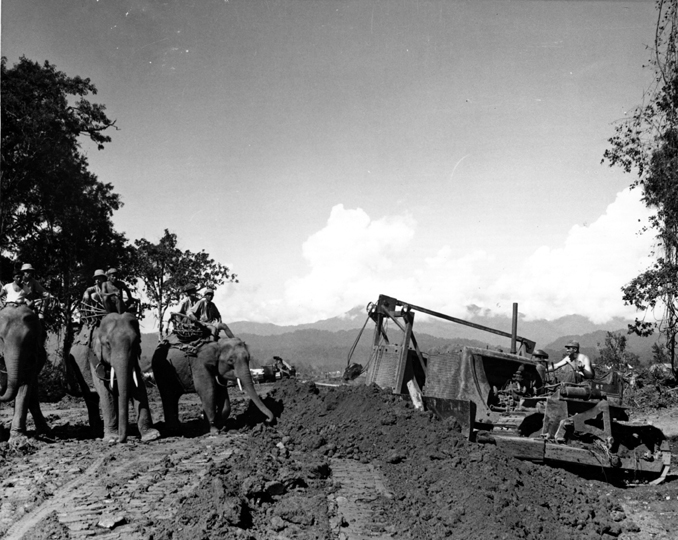 The first bulldozer reached Shingbwiyang on December 27, 1943, three days ahead of schedule. The building of this section allowed much-needed supplies to flow to the troops engaged in attacking the 18th Japanese Division, which was defending the northern area of Burma with their strongest forces around the towns of Kamaing, Mogaung, and Myitkyina. Before the Ledo Road reached Shingbwiyang, Allied troops (the majority of whom were American-trained Chinese divisions of the X Force) had been totally dependent on supplies flown in over the Patkai Range. As the Japanese were forced to retreat south, the Ledo Road was extended. This was made considerably easier by Shingbwiyang by the presence of a fair weather road built by the Japanese, and the Ledo Road generally followed the Japanese trace. As the road was built, two 4-inch (100-MM) fuel pipelines were laid side by side so that fuel for the supply vehicles could be piped instead of trucked along the road.
The first bulldozer reached Shingbwiyang on December 27, 1943, three days ahead of schedule. The building of this section allowed much-needed supplies to flow to the troops engaged in attacking the 18th Japanese Division, which was defending the northern area of Burma with their strongest forces around the towns of Kamaing, Mogaung, and Myitkyina. Before the Ledo Road reached Shingbwiyang, Allied troops (the majority of whom were American-trained Chinese divisions of the X Force) had been totally dependent on supplies flown in over the Patkai Range. As the Japanese were forced to retreat south, the Ledo Road was extended. This was made considerably easier by Shingbwiyang by the presence of a fair weather road built by the Japanese, and the Ledo Road generally followed the Japanese trace. As the road was built, two 4-inch (100-MM) fuel pipelines were laid side by side so that fuel for the supply vehicles could be piped instead of trucked along the road.
The 45th began work with six D-4 bulldozers and no blades, but it managed to borrow one from a British engineering unit. As a result, the first part of the road was rather winding as the D-4 was too light for the rugged terrain and had to detour around obstacles. The 45th was also short of heavy rock crushers, but it did have 11 portables which were set up at the Tirap River near Ledo. By the first of the new year, the engineers were working around the clock and making good progress. The 823d’s full complement of equipment had finally arrived and the unit pushed forward rapidly toward the Patkai Mountains. As it moved into the hills, progress slowed due to the difficult terrain. Continuous use of equipment without periodic maintenance and a shortage of spare parts contributed to the slowdown. In February 1943, the engineers reached Pangsau Pass where rock outcroppings caused the 823d to increase its use of explosives. In one case, it was necessary to place charges 30 feet up a perpendicular rock face. Here one engineer hung by a rope lowered from the top to place dynamite that another engineer tossed up to him; an efficient but dangerous technique.
Through February, the 823d pushed for the India-Burma Border. Able Co broke trace, Baker Co put in culverts, and Charlie Co widened and ditched the roadway. Only construction vehicles were allowed in the forward area. When Pvt Morris Humphrey stopped the SOS commander’s jeep, Gen Wheeler commended him for carrying out his orders and walking the 2 miles to the road head. From long experience ‘Spec’ Wheeler knew the ways and whims of engineers.
The 823d reached the border on February 28. As the lead bulldozer crossed into Burma, a bugler sounded To the Colors, and the 823d and the 45th Engineers held a retreat parade. Then they put up a sign: WELCOME TO BURMA – THIS WAY TO TOKYO. In March, the Chinese 10th Independent Combat Engineer Regiment arrived at Ledo from its Ramgarh, India, training base. Without equipment, the unit was outfitted with hand tools and trucks and sent to the road head to help clear the trace. Later, when its equipment arrived, the 10th became one of the best construction outfits on the road. March also brought early monsoon rains, and that meant trouble for the engineers. By the first week in April, the monsoon was in full swing. As the rains poured down, the engineers were constantly wet, equipment skidded off the road into ditches, and even pack animals could not transport food and gasoline to the road head. Airdrops became necessary for re-supply.
 The Japanese now reacted to the road construction. With the threat of an Allied offensive, they formed a second army in Burma and placed the 18th Division Commander, Gen Mutaguchi, in charge. Gen Shinichi Tanaka took over command of the 18th Division. Reacting to guerrilla activity by Kachin tribesmen, small columns from the 18th moved north up the valleys from Myitkyina toward the Patkais and the Ledo Road. The Japanese had trouble with the terrain, and airstrikes caused the contractors who provided the elephants for the pack trains to run away with their animals. Short of supplies, the Japanese withdrew south.
The Japanese now reacted to the road construction. With the threat of an Allied offensive, they formed a second army in Burma and placed the 18th Division Commander, Gen Mutaguchi, in charge. Gen Shinichi Tanaka took over command of the 18th Division. Reacting to guerrilla activity by Kachin tribesmen, small columns from the 18th moved north up the valleys from Myitkyina toward the Patkais and the Ledo Road. The Japanese had trouble with the terrain, and airstrikes caused the contractors who provided the elephants for the pack trains to run away with their animals. Short of supplies, the Japanese withdrew south.
After the initial section to Shingbwiyang, more sections followed: Warazup, Myitkyina, and Bhamo, 372 miles (598 KM) from Ledo. At that point the road joined a spur of the old Burma Road and, although improvements to further sections followed, the road was passable. The spur passed through Namkham 439 miles (706 KM) from Ledo and finally, at the Mong-Yu Road Junction, 465 miles (748 KM) from Ledo, the Ledo Road met the Burma Road. To get to the Mong-Yu Junction the Ledo Road had to span 10 major rivers and 155 secondary streams, averaging one bridge every 2.8 miles (4.5 KM).
Work continued through 1944 and in late December, it was opened for the transport of logistics. In January 1945, four of the black EABs (along with three white battalions) continued working on the now-renamed Stilwell Road, improving and widening it. Indeed, one of these African American units was assigned the task of improving the road that extended into China.
For the first convoys, if they turned right, they were on their way to Lashio, 100 miles (257 KM), to the south through Japanese-occupied Burma. If they turned left, Wanting lay 60 miles (96 KM) to the north just over the China-Burma Border. However, by late 1944, the road still did not reach China; by this time, tonnage airlifted over the Hump to China had significantly expanded with the arrival of more modern transport aircraft. In late 1944, barely two years after Stilwell accepted responsibility for building the Ledo Road, it connected to the Burma Road despite the fact that some sections of the road beyond Myitkyina at the Hukawng Valley were under repair due to heavy monsoon rains. It became a highway stretching from Assam, India to Kunming, China 1079 miles (1736 KM) in length. On January 12, 1945, the first convoy of 113 vehicles, led by Gen Pick, departed from Ledo; they reached Kunming, China on February 4, 1945. In the six months following its opening, trucks carried 129.000 tons of supplies from India to China. Twenty-six thousand trucks that carried the cargo (one way) were handed over to the Chinese.
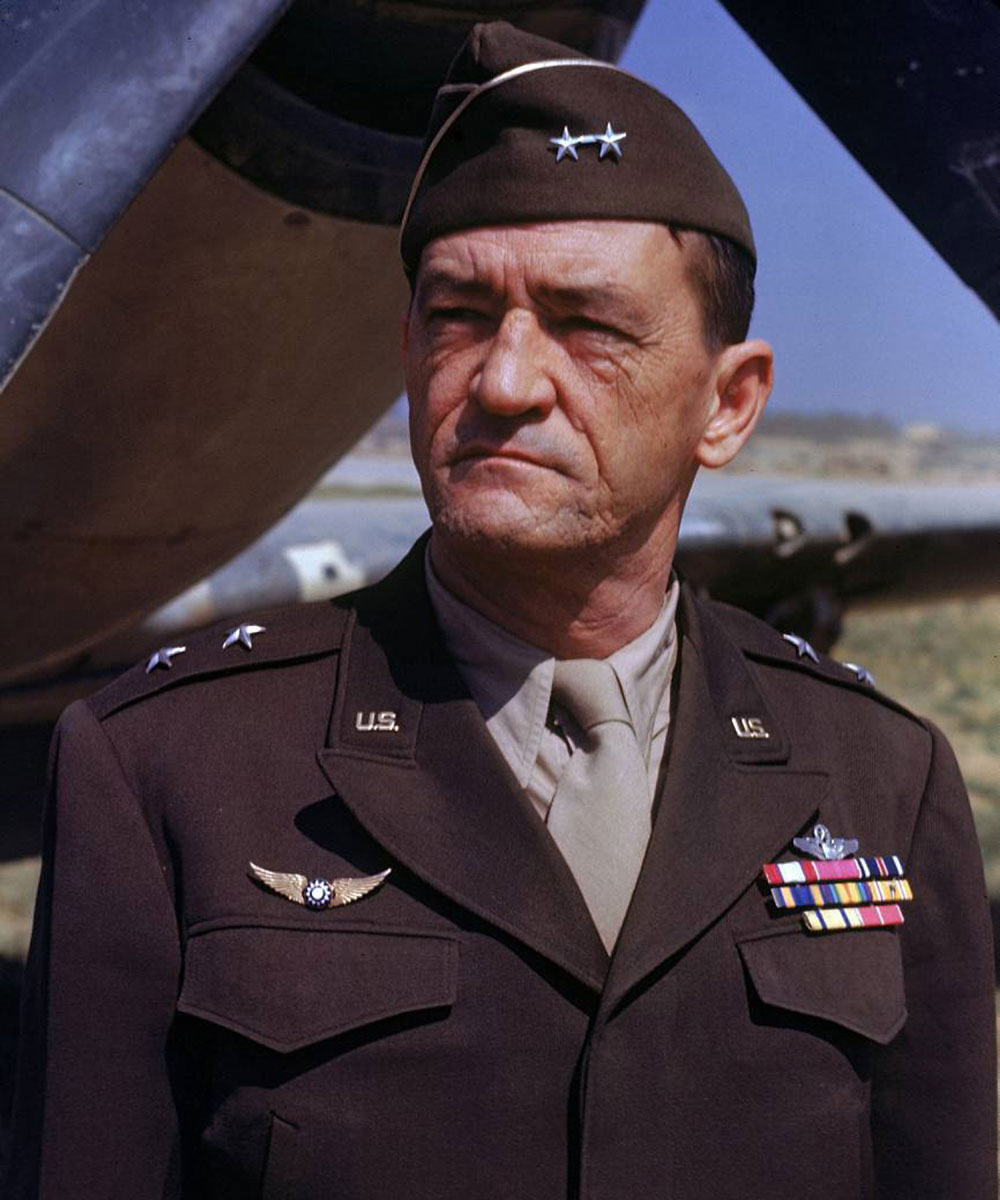 As Gen Claire Lee Chennault had predicted, supplies carried over the Ledo Road at no time approached tonnage levels of supplies airlifted monthly into China over the Hump. The road, however, complemented the airlift. The capture of the airstrip in Myitkyina enabled the Air Transport Command to fly a more southerly route without fear of Japanese fighters, thus shortening and flattening the Hump trip with astonishing results. In July 1943, the air tonnage was 5500 rising to 8000 in September and 13000 in November. After the capture of Myitkyina deliveries jumped from 18.000 tons in June 1944 to 39.000 in November 1944. In July 1945, the last full month before the end of the war, 71.000 tons of supplies were flown over the Hump, compared to only 6000 tons using the Ledo Road; the airlift operation continued in operation until the end of the war, with a total tonnage of 650.000 tons compared to 147.000 for the Ledo Road. By the time supplies were flowing over the Ledo Road in large quantities, operations in other theaters had shaped the course of the war against Japan.
As Gen Claire Lee Chennault had predicted, supplies carried over the Ledo Road at no time approached tonnage levels of supplies airlifted monthly into China over the Hump. The road, however, complemented the airlift. The capture of the airstrip in Myitkyina enabled the Air Transport Command to fly a more southerly route without fear of Japanese fighters, thus shortening and flattening the Hump trip with astonishing results. In July 1943, the air tonnage was 5500 rising to 8000 in September and 13000 in November. After the capture of Myitkyina deliveries jumped from 18.000 tons in June 1944 to 39.000 in November 1944. In July 1945, the last full month before the end of the war, 71.000 tons of supplies were flown over the Hump, compared to only 6000 tons using the Ledo Road; the airlift operation continued in operation until the end of the war, with a total tonnage of 650.000 tons compared to 147.000 for the Ledo Road. By the time supplies were flowing over the Ledo Road in large quantities, operations in other theaters had shaped the course of the war against Japan.
The road was built by 15.000 American soldiers (60 percent of whom were African-Americans) and 35.000 local workers at a cost of US $150 million. 1100 Americans died during the construction, as well as many more locals. As most of Burma was in Japanese hands it was not possible to acquire information as to the topography, soils, and river behavior before construction started. This information had to be acquired as the road was constructed.











 </a
</a